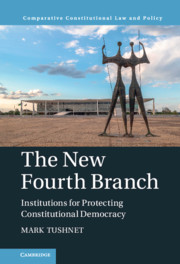Book contents
- The New Fourth Branch
- Comparative Constitutional Law and Policy
- The New Fourth Branch
- Copyright page
- Contents
- Acknowledgments
- 1 Introduction
- 2 Why a Fourth Branch?
- 3 Why a Fourth Branch?
- 4 Design Issues in General
- 5 Design Principles in Practice
- 6 Anti-corruption Investigations
- 7 Electoral Commissions
- 8 Audit Agencies
- 9 Conclusion
- Index
2 - Why a Fourth Branch?
The Structural Logic
Published online by Cambridge University Press: 20 August 2021
- The New Fourth Branch
- Comparative Constitutional Law and Policy
- The New Fourth Branch
- Copyright page
- Contents
- Acknowledgments
- 1 Introduction
- 2 Why a Fourth Branch?
- 3 Why a Fourth Branch?
- 4 Design Issues in General
- 5 Design Principles in Practice
- 6 Anti-corruption Investigations
- 7 Electoral Commissions
- 8 Audit Agencies
- 9 Conclusion
- Index
Summary
Constitutional theory dating to Montesquieu identified three branches of government, each with a specific function: the legislature enacted general rules, the executive enforced the rules, and the judiciary resolved disputes about the rules’ meaning and application. Every government had to have these branches in some form; that is, the branches were necessary elements in a governance structure. In addition, the branches were exhaustive; that is, taken together they did everything a government could do.1
- Type
- Chapter
- Information
- The New Fourth BranchInstitutions for Protecting Constitutional Democracy, pp. 8 - 24Publisher: Cambridge University PressPrint publication year: 2021

